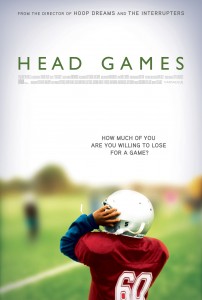
The concern over injuries related to sports is not exactly a new phenomenon, although the types of injuries that provoke the concern have changed dramatically in recent years. Particularly in football and hockey, there have been increasing attention paid regarding the impact of concussions and their long-term effects on athletes.
Back in 2006, former college football and professional wrestler Chris Nowinski released a book about concussions in the National Football League and college, Head Games: Football’s Concussion Crisis. A graduate of Harvard University and a linebacker on their football team, Nowinski joined World Wrestling Entertainment through their Tough Enough reality television show in 2001. After suffering a serious in-ring concussion, Nowinski retired in 2005 and began investigating his symptoms, which led to the creation of the book. The book has been expanded into a documentary, Head Games, directed by Hoop Dreams helmer Steve James.
While the book primarily concerned itself with professional and college football, the film expands the scope with a fairly simple thesis: It’s not just professional football players that we should be worried about. People of many ages and from many different sports are suffering, too.
The film begins with a primer on Nowinski’s life and career, then jumps into his transition from the wrestling ring into a concussion awareness advocate. Since writing the book, he’s co-founded the Sports Legacy Institute, devoted to the study of concussions, brain trauma and chronic traumatic encephalopathy – a degenerative brain disorder linked to memory issues, dementia, confusion and depression. Much of the film looks at the science behind CTE and its impact on former athletes, although the doctors appearing on-screen acknowledge that the disorder is still very early stages of being studied and so there are still a lot of things that aren’t known yet.
While a large chunk of the film is devoted to football, a fairly large portion of the film looks at hockey, both at the youth and National Hockey League level. The entry point for the hockey examination is, strangely, former NHLer Keith Primeau. A 15-year veteran of the NHL, Primeau retired in 2006 due to complications from post-concussion syndrome. The film, and Primeau, walk the viewer through his concussions in slow, agonizing detail, and also detail the progression of his symptoms, his struggles through recovery and the decision to retire from the game.
The film also introduces a handful of teenage players – including Primeau’s son Chayse and Peter Laviolette III, the son of Philadelphia Flyers head coach Peter Laviolette. The youngsters explain how many concussions they have had, and given the presence of so much footage of so many older athletes with similar tales and very uncertain futures, their inclusion is extremely unnerving.
It could also be argued that’s the entire point of their inclusion in the film, and the film itself.
The entire hockey segment of the film exists as a very captivating companion piece to the hockey work done by HBO Sports in recent years. In particular, the inclusion of the elder Peter Laviolette harkens back to his appearance on the most recent season of 24/7: Road to the NHL Winter Classic, where he had to deal with a concussion suffered by star player Claude Giroux. When discussing his own son’s head injuries, he stressed the importance of being very careful with concussions, whether dealing with your own child or with an NHL player.
Arguably the impactful, lasting moment from the film occurs at the very end. Driving his kids to the arena, Primeau explains his family’s history of concussions, then notes that he’s allowing his children to decide whether or not to participate in contact sports. After all, he reasons, you can’t live in fear.
It’s an interesting post-script for a film that openly questions how much players (and parents, and coaches, and others around sports) are willing to lose for a game.